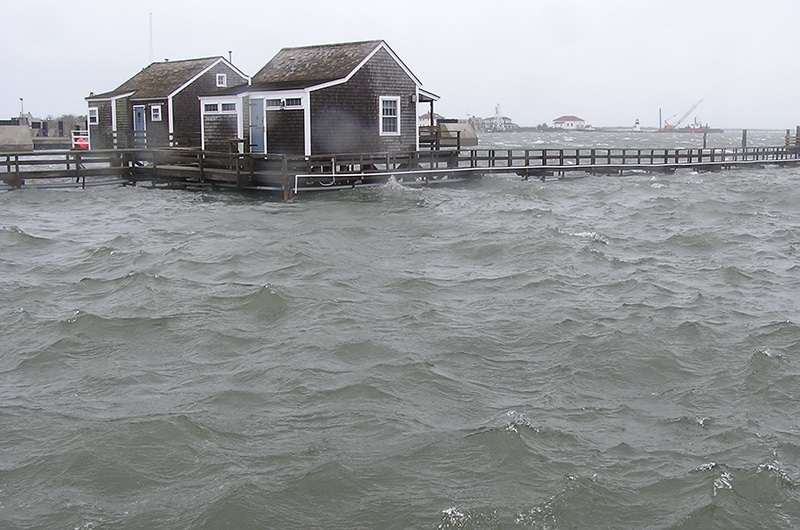by Sarah Treanor Bois, Director of Research & Education for the Linda Loring Nature Foundation

The first thing Nantucket is doing is to be prepared in the event of a storm. And not just in the days before a storm, boarding up windows and putting down sand-bangs. The Town of Nantucket has been working on its Climate Resiliency. Climate Resiliency is defined by the National Oceanic and Atmospheric Association (NOAA) as the “ability of a community to ‘bounce back’ after hazardous events such as hurricanes, coastal storms, and flooding, rather than simply reacting to impacts.” Nantucket has been working on its resiliency for the last decade or so.
Storms have the potential to damage infrastructure through wind, precipitation, and ocean flooding. While high winds can cause serious damage, it is predicted that the greatest risk comes in the form of storm surge. Storm surge is the rise in water level, over and above the regular astronomical tide, caused by a severe storm.
Over the past several years, storms and storm surges have taken a major toll on Nantucket. After Hurricane Sandy, the total estimated damages were approximately $125,000, with $90,000 of these damages being to the Washington Street piers. After the nor’easter Juno, the total estimated damages were $1,700,000, and $1,200,000 of the damages were inflicted on the town pier. Damage to a community’s critical infrastructure threatens the public health, environment, and economy; therefore, preventative planning through mitigation tactics are essential. What is our town doing to protect our critical infrastructure?

In 2014, the Town completed the Coastal Management Plan which evaluated the conditions of town-owned infrastructure and made suggestions on those that needed protection. One of the first things acted on was the improvement of the Easy Street bulkhead. Improvements to the bulkhead were completed in 2017 in an effort to reduce flooding, particularly storm surge associated with extreme high tides. Town emergency-preparedness coordinator David Fronzuto said the new bulkhead is raised, and float valves have been installed over all four storm drains to allow for water to escape if it gets trapped behind the bulkhead.

In addition, the storm water improvement program has been working to mitigate on-going flooding due to undersized drainage pipes. These improvements started with Children’s Beach and Orange Street. The new, larger pipes and “Best Management Practices” tanks for run-off treatment have since reduced flooding in both of those areas. Future improvement plans for drainage and catch basins include India Street, South Water Street, and East Chestnut Street.
Another infrastructure project was completed in 2017 with the improvements and repairs to the east and west jetties. These jetties provide protection not only for vessels entering and exiting the harbor but as a “harbor of refuge” for transiting ships looking to safely weather significant storm events throughout the year.
The jetties had sustained damage during Hurricane Sandy in October 2012. The recently completed project, funded by the U.S. Army Corps of Engineers, will improve water flow in the channel and flush the harbor with the tides as huge holes in the jetties were plugged. The height of the jetties was also raised to avoid the number of boat accidents hitting the jetties which had increased in recent years.
Students from Worcester Polytechnic Institute conducted a comprehensive review of Nantucket’s vulnerable infrastructure in 2015. Among their findings were differentiating what infrastructure should be relocated, which should be elevated, and which should be “flood proofed” if not relocatable. High priorities were identified as the Sea Street Pump Station and the Candle Street Substation, both of which are highly vulnerable to high tides and within the 100-year flood zone. Since Candle Street Substation is the central hub for electrical distribution to the island, it is one of the most important facilities in the downtown area. Sea Street Pump Station collects wastewater from the downtown area and pumps it to the island’s Wastewater Treatment Plant; therefore, it is the most critical pump on the island. Recently, the Town has moved to make improvements to the Sea Street Pump Station. When it is complete, it will have a state-of-the-art control system that can be accessed remotely and have pumps designed to work even if they are under water in case of a flood.
While our Town is working over the long-term to repair, improve, or move our vital infrastructure, thus improving our climate resiliency, there are things residents can do now to prepare for a storm. Visit the Town of Nantucket’s website at nantucket-ma.gov/298/Emergency-Preparedness for local Emergency Preparedness information, including links to FEMA, emergency shelter information, and emergency information broadcast sources.
To learn more about the hazards associated with hurricanes and tropical storms, visit the Massachusetts Emergency Management Agency’s hurricane webpage: mass.gov/mema/hurricanes.


